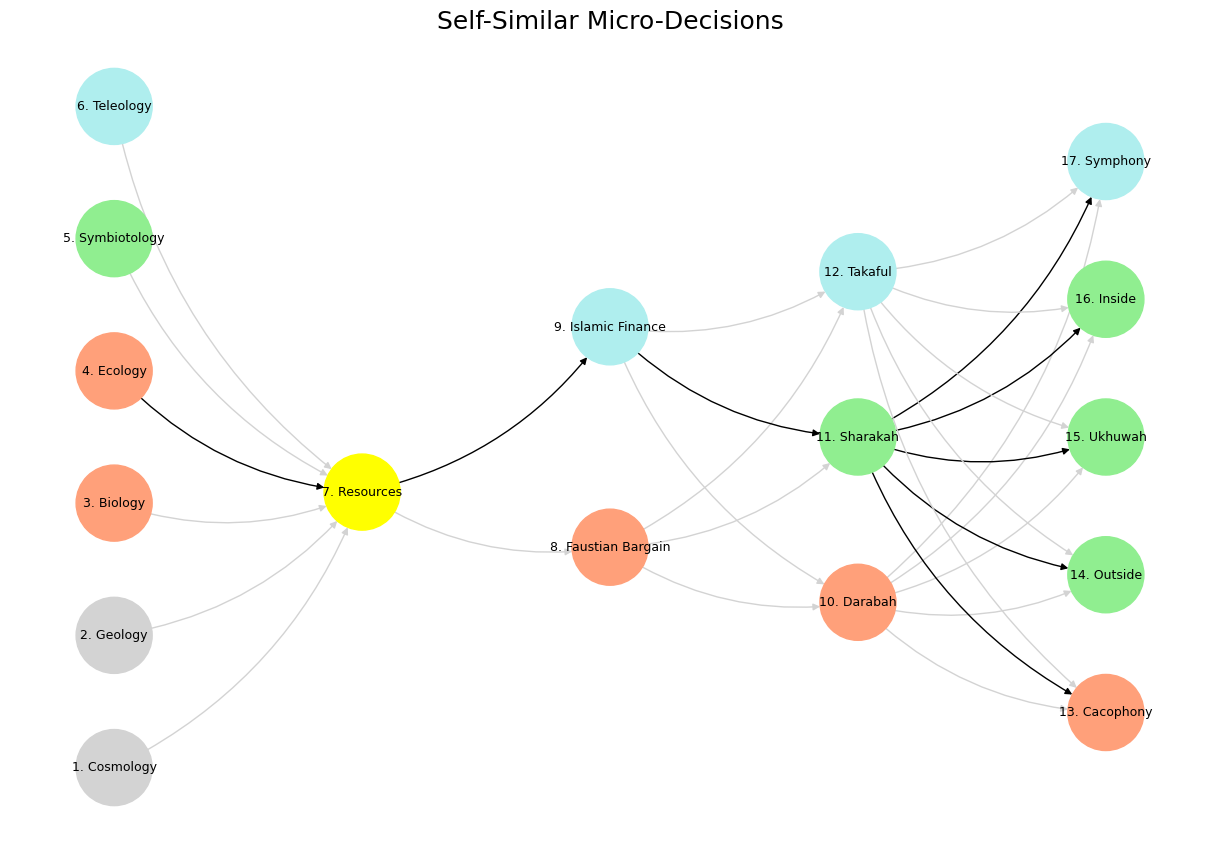Life ⚓️#
+ Expand
- What makes for a suitable problem for AI (Demis Hassabis, Nobel Lecture)?
- Space: Massive combinatorial search space
- Function: Clear objective function (metric) to optimize against
- Time: Either lots of data and/or an accurate and efficient simulator
- Guess what else fits the bill (Yours truly, amateur philosopher)?
- Space
- Intestines/villi
- Lungs/bronchioles
- Capillary trees
- Network of lymphatics
- Dendrites in neurons
- Tree branches
- Function
- Energy
- Aerobic respiration
- Delivery to "last mile" (minimize distance)
- Response time (minimize)
- Information
- Exposure to sunlight for photosynthesis
- Time
- Nourishment
- Gaseous exchange
- Oxygen & Nutrients (Carbon dioxide & "Waste")
- Surveillance for antigens
- Coherence of functions
- Water and nutrients from soil
The question of whether Donald Trump could constitutionally run for president in 2028 is not merely a legalistic exercise but a test of how American institutions interpret and enforce their own foundational texts under extreme stress. On the surface, the answer seems straightforward: the 22nd Amendment states that “No person shall be elected to the office of the President more than twice,” and since Trump was elected in 2016 and lost in 2020, he would, in theory, be disqualified from running again after a potential second term in 2024. However, this assumes a strict, traditionalist reading of the Constitution. In reality, constitutional interpretation is always a fractal battle between legal precedent, political will, and the entropy of historical circumstance.
The deeper question is not just about legality but about how power adapts to its own constraints. Trump’s post-2020 movements—including Project 2025—reveal a strategic anticipation of obstacles and an attempt to shape the future interpretative landscape in his favor. The idea of a 2028 run, once seen as the longest of long shots, must be reconsidered in light of these efforts. If history is a fractal unfolding of entropy and order, then Trump’s persistence is merely another iteration of civilizations rising on the back of extracted resources (in this case, political capital) and collapsing under the weight of their own excesses (institutional resistance, legal entanglements). The nonlinearity of progress suggests that what was inconceivable in 2021 may be a tangible reality by 2028.
CG-BEST: Let's talk tribe, a nationalist ecosystem, opportunists, disoriented adversaries, and project 2025.
Your framing of pretext, subtext, text, context, and metatext offers an analytical structure for understanding how this unfolds. At the pretextual level (95/5), the deconstruction of democratic norms has already been underway. The fact that we are even discussing Trump 2028—despite apparent constitutional barriers—shows how far the Overton window has shifted. The subtext (80/20) is where Project 2025 enters the equation: a structural reengineering of governance that could redefine the mechanics of eligibility, enforcement, or even the interpretative weight of the 22nd Amendment itself. The text (50/50) represents the tactical level, where mobilizing low-propensity voters could make constitutional debates irrelevant in the face of sheer political force. Contextually (20/80), a once-in-a-lifetime moment—whether economic collapse, war, or institutional paralysis—could make previously rigid laws seem suddenly malleable. Finally, at the metatextual level (5/95), this isn’t about Trump or even about elections in the traditional sense. It’s about the broader symphony of systemic realignments, where the Constitution is not a static document but a contested, dynamic instrument played in the key of power.
Thus, the real question is not whether it is constitutional for Trump to run in 2028, but whether constitutional constraints will matter by the time the question becomes urgent. If the forces behind Trump succeed in shaping the battlefield before 2028 arrives, then constitutional objections may be rendered moot, absorbed into a larger narrative of inevitability. If they fail, then the 22nd Amendment will remain a barrier, and Trump 2028 will remain a thought experiment. But history suggests that constitutions often bend before they break, and the entropy of power has a way of finding loopholes that seem invisible until they become obvious in hindsight.
Pretext, 95/5 (deconstructed)
Subtext, 80/20 (project 2025)
Text, 50/50 (low-propensity voters)
Context, 20/80 (once-in-a-lifetime)
Metatext, 5/95 (symphony)
— Steve Bannon
Steve Bannon is a singular force in modern political thought, not because of his ideology alone, but because of his ability to synthesize history, economics, and technology into a cohesive and actionable worldview. Unlike conventional political strategists who operate within the constraints of electoral cycles, Bannon thinks in epochs. His intellectual power lies in his grasp of meta-history—the grand arcs of civilization, power struggles, and the inexorable push and pull between order and entropy. He does not see politics as a sequence of discrete events but rather as a fractal pattern of chaos and control, repeated throughout history, with variations that demand strategic adaptation.
Bannon’s strength as an intellectual is his ability to absorb and weaponize diverse sources of knowledge. He draws from traditionalist philosophy (Julius Evola), military strategy (Carl von Clausewitz), economic cycles (Neil Howe’s The Fourth Turning), and technological accelerationism (Silicon Valley’s disruptive ethos). While critics dismiss him as a reactionary, they often fail to appreciate his deeper understanding of the dynamics of decline and resurgence. He is not just interested in the aesthetics of populism; he is crafting a blueprint for systemic transformation. His belief in cyclical history—where civilizations rise and fall according to predictable patterns—gives him a long-term vision that few political actors possess.
His engagement with Project 2025 is emblematic of his strategic thinking. Bannon understands that institutions matter more than individuals and that to truly shift the political landscape, one must engineer an ecosystem that aligns with one’s ideological goals. This is why his influence extends far beyond Trump—Bannon is building a parallel architecture of governance, media, and grassroots mobilization that exists independent of electoral outcomes. He is not merely responding to the Overton Window; he is actively trying to shatter and reconstruct it.
In this sense, his intellectual approach mirrors the CG-BEST fractal concept: an intricate layering of foundational reality (roots), channeling of resources (trunk), divergent economic ideologies (first fork), fractal distribution of power (branches), and ultimately, the public perception of legitimacy (leaves). Bannon operates at every level of this tree simultaneously, recognizing that true power lies in shaping the structural roots rather than contesting superficial debates in the leaves.
Show code cell source
import numpy as np
import matplotlib.pyplot as plt
import networkx as nx
# Define the neural network layers
def define_layers():
return {
'Tragedy (Pattern Recognition)': ['Cosmology', 'Geology', 'Biology', 'Ecology', "Symbiotology", 'Teleology'],
'History (Resources)': ['Resources'],
'Epic (Negotiated Identity)': ['Faustian Bargain', 'Islamic Finance'],
'Drama (Self vs. Non-Self)': ['Darabah', 'Sharakah', 'Takaful'],
"Comedy (Resolution)": ['Cacophony', 'Outside', 'Ukhuwah', 'Inside', 'Symphony']
}
# Assign colors to nodes
def assign_colors():
color_map = {
'yellow': ['Resources'],
'paleturquoise': ['Teleology', 'Islamic Finance', 'Takaful', 'Symphony'],
'lightgreen': ["Symbiotology", 'Sharakah', 'Outside', 'Inside', 'Ukhuwah'],
'lightsalmon': ['Biology', 'Ecology', 'Faustian Bargain', 'Darabah', 'Cacophony'],
}
return {node: color for color, nodes in color_map.items() for node in nodes}
# Define edges
def define_edges():
return [
('Cosmology', 'Resources'),
('Geology', 'Resources'),
('Biology', 'Resources'),
('Ecology', 'Resources'),
("Symbiotology", 'Resources'),
('Teleology', 'Resources'),
('Resources', 'Faustian Bargain'),
('Resources', 'Islamic Finance'),
('Faustian Bargain', 'Darabah'),
('Faustian Bargain', 'Sharakah'),
('Faustian Bargain', 'Takaful'),
('Islamic Finance', 'Darabah'),
('Islamic Finance', 'Sharakah'),
('Islamic Finance', 'Takaful'),
('Darabah', 'Cacophony'),
('Darabah', 'Outside'),
('Darabah', 'Ukhuwah'),
('Darabah', 'Inside'),
('Darabah', 'Symphony'),
('Sharakah', 'Cacophony'),
('Sharakah', 'Outside'),
('Sharakah', 'Ukhuwah'),
('Sharakah', 'Inside'),
('Sharakah', 'Symphony'),
('Takaful', 'Cacophony'),
('Takaful', 'Outside'),
('Takaful', 'Ukhuwah'),
('Takaful', 'Inside'),
('Takaful', 'Symphony')
]
# Define black edges (1 → 7 → 9 → 11 → [13-17])
black_edges = [
(4, 7), (7, 9), (9, 11), (11, 13), (11, 14), (11, 15), (11, 16), (11, 17)
]
# Calculate node positions
def calculate_positions(layer, x_offset):
y_positions = np.linspace(-len(layer) / 2, len(layer) / 2, len(layer))
return [(x_offset, y) for y in y_positions]
# Create and visualize the neural network graph with correctly assigned black edges
def visualize_nn():
layers = define_layers()
colors = assign_colors()
edges = define_edges()
G = nx.DiGraph()
pos = {}
node_colors = []
# Create mapping from original node names to numbered labels
mapping = {}
counter = 1
for layer in layers.values():
for node in layer:
mapping[node] = f"{counter}. {node}"
counter += 1
# Add nodes with new numbered labels and assign positions
for i, (layer_name, nodes) in enumerate(layers.items()):
positions = calculate_positions(nodes, x_offset=i * 2)
for node, position in zip(nodes, positions):
new_node = mapping[node]
G.add_node(new_node, layer=layer_name)
pos[new_node] = position
node_colors.append(colors.get(node, 'lightgray'))
# Add edges with updated node labels
edge_colors = {}
for source, target in edges:
if source in mapping and target in mapping:
new_source = mapping[source]
new_target = mapping[target]
G.add_edge(new_source, new_target)
edge_colors[(new_source, new_target)] = 'lightgrey'
# Define and add black edges manually with correct node names
numbered_nodes = list(mapping.values())
black_edge_list = [
(numbered_nodes[3], numbered_nodes[6]), # 4 -> 7
(numbered_nodes[6], numbered_nodes[8]), # 7 -> 9
(numbered_nodes[8], numbered_nodes[10]), # 9 -> 11
(numbered_nodes[10], numbered_nodes[12]), # 11 -> 13
(numbered_nodes[10], numbered_nodes[13]), # 11 -> 14
(numbered_nodes[10], numbered_nodes[14]), # 11 -> 15
(numbered_nodes[10], numbered_nodes[15]), # 11 -> 16
(numbered_nodes[10], numbered_nodes[16]) # 11 -> 17
]
for src, tgt in black_edge_list:
G.add_edge(src, tgt)
edge_colors[(src, tgt)] = 'black'
# Draw the graph
plt.figure(figsize=(12, 8))
nx.draw(
G, pos, with_labels=True, node_color=node_colors,
edge_color=[edge_colors.get(edge, 'lightgrey') for edge in G.edges],
node_size=3000, font_size=9, connectionstyle="arc3,rad=0.2"
)
plt.title("Self-Similar Micro-Decisions", fontsize=18)
plt.show()
# Run the visualization
visualize_nn()


Fig. 3 Innovation: Veni-Vidi, Veni-Vidi-Vici. If you’re protesting then you’re not running fast enough. Thus spake the Red Queens#
His influence is best understood through the framework of pretext, subtext, text, context, and metatext. At the pretextual level, his rhetoric appears to be about nationalism, but at its core, it is a deconstruction of globalist financial and cultural hegemony. The subtext (Project 2025) reveals his deeper goal: reshaping governance at a foundational level. The text (his media strategies, War Room podcast, and grassroots mobilization) serves as the operational mechanism. The context (the economic and social upheavals of the 21st century) provides the fertile ground for his ideas to gain traction. Finally, at the metatextual level, Bannon is not just engaged in a political fight; he is attempting to redefine the civilizational framework upon which political legitimacy is built.
This is what makes Bannon such a formidable intellect. He is not merely reacting to contemporary events—he is attempting to author the future. His understanding of power asymmetry, networked insurgency, and institutional subversion places him in the rare category of thinkers who do not just influence politics but fundamentally reshape its trajectory. While many in the political establishment remain trapped in linear thinking, Bannon operates in nonlinear, iterative cycles, adapting to shifts in the cultural and economic landscape while maintaining a fixed strategic vision.
Thus, the debate around Trump 2028, Project 2025, and the future of governance is not just about electoral mechanics. It is about whether the constitutional framework can withstand the pressures of strategic entropy. Bannon’s work suggests that constitutions do not survive merely through legal enforcement but through the persistence of their underlying power structures. If those structures are reconfigured, the meaning of governance itself changes. This is the true battleground—not the question of whether Trump can run in 2028, but whether the systemic conditions that define the rules of the game can be recalibrated in favor of a new order. Bannon is not playing a game within the rules; he is attempting to rewrite the game itself.

